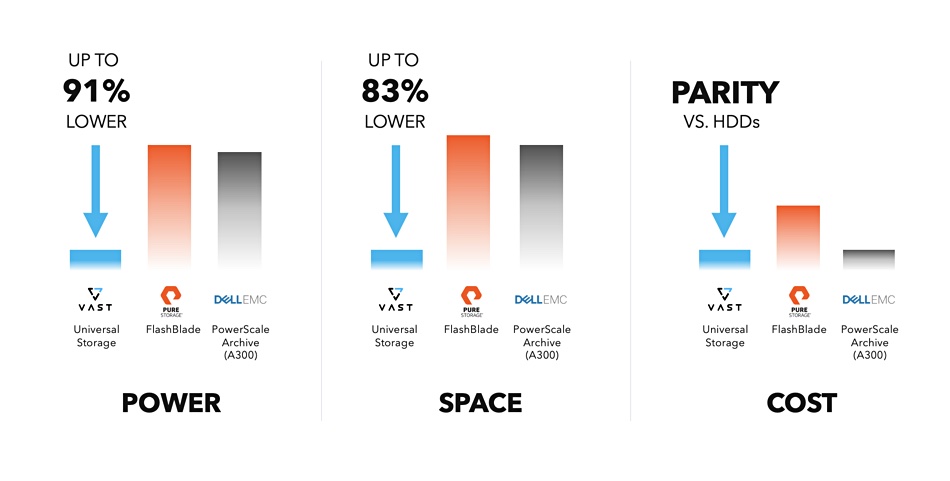VAST Data has doubled the storage density of its all-flash Universal Storage hardware to 1350TB of raw capacity, by supporting Intel 30TB QLC NVMe SSDs. That’s over a petabyte of effective capacity per rack unit at 5:1 data reduction.
This qualifies it to claim in a blog that, by providing twice the capacity in the same two rack units and the same power consumption, it cuts datacentre costs for space, power and cooling. It also has a Universal Power Control feature coming next year. This will enforce limits on system power consumption by intelligently scheduling CPUs to reduce peak power draw by 33 per cent as the power drawn by the system reaches a set limit.
VAST co-founder Jeff Denworth said: “With this announcement, we are eliminating all of the arguments for HDD-based infrastructure and making it even easier for customers to reach the all-silicon datacentre destination we first charted back in 2018.”
The blog explains: “The method behind Universal Power Control is pretty simple … hard drives draw more power when they’re moving their heads, SSDs draw much more power when accepting data writes than when processing reads. The write/erase cycle just uses more power than processing reads. With Universal Power Control, as the power drawn by the system reaches the power limit, the system starts reducing the number of active VAST Protocol Servers (aka CNodes), which reduces the rate at which the system writes data. Such an approach would be impossible with direct-attached shared-nothing storage architectures that tightly couple CPUs with storage devices.”
The blog compares compare a cluster of VAST 1350TB enclosures with Dell’s PowerScale A300 — an enterprise HDD-based archive system — and Pure’s all-flash scale-out FlashBlade systems. It says “A 4U FlashBlade chassis holds 15 blades, each with 52TB of flash delivering 535TB of usable capacity and consuming 1800W. … The PowerScale A300 nodes hold 15x 16TB hard drives per node, with four nodes in a 4U chassis that consumes 1070W. Assuming 20 per cent overhead for data protection, virtual hot spares, and the like, each chassis will deliver 768TB of useable space.”
It includes a graphic comparing VAST, Dell’s PowerScale A300 and the Pure FlashBlade systems:

The company claims that, by running at just 500 watts per petabyte (with the coming Universal Power Control), it is 11x more power efficient than Dell’s PowerScale A300 and up to 9x more power efficient than Pure’s Flashblade offering. It says it has a 5x datacentre density advantage over the PowerScale and FlashBlade products as well.
The blog also points out that HDD rebuild times are much longer than SSD rebuild times.
VAST says an unnamed large global financial customer has bought a more than 200PB VAST system to consolidate its performance and archive tiers from mostly HDDs into a single flash-based store.
The new 30TB drives can be mixed and matched in VAST systems with the existing 15TB SSDs in a single cluster.








